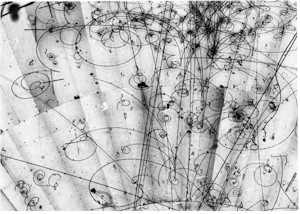Physics Hint 2
A positron going through matter can hit an electron, annihilating both and producing two gamma ray photons. However, an electron could never disappear. So look for a track that simply disappears (the gamma rays make no track). For a high-energy positron, these gamma rays will be produced nearly in the forward direction, and sometimes one of these will turn back into an electron positron pair as it passes close to an atomic nucleus (such as from one of the liquid hydrogen atoms). So another thing to look for is a track that disappears (positron-electron annihilation) and then seems to reappear later as a pair of oppositely curving tracks (electron-positron pair creation).
The bubble chamber is a good example of a "physics-rich" problem, a real-world problem that requires the integration of many ideas that students in the past usually learned in isolation. Ideas from mechanics, electricity and magnetism, elementary particle physics, and thermodynamics must be combined to obtain a good understanding of the bubble chamber. Physics students at Fredonia will encounter many such interesting and challenging problems throughout the curriculum, in both the classroom and the laboratory. Besides their instructional value, problems such as this often illustrate the beauty - the simplicity among complexity - that typifies the investigation of nature at the most fundamental scales that is the realm of physics.

